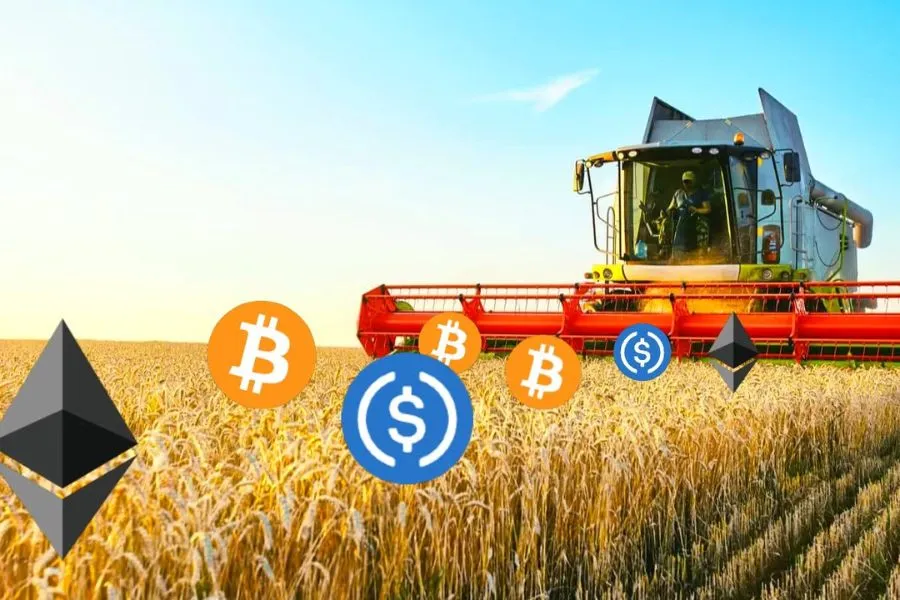If you’ve been around the crypto world long enough, you’ve probably heard the phrase “yield farming” tossed around like it’s the hottest thing since Bitcoin itself. For some, it sounds like a magical money tree. For others, it’s a confusing buzzword that feels like you need a PhD in blockchain to understand. But don’t worry—you don’t need to be Vitalik Buterin to figure this out. Let’s break down yield farming in crypto, how it works, and why it’s become one of the most popular ways to earn passive income in decentralized finance (DeFi).
Table of Contents
What Exactly Is Yield Farming in Crypto?
At its core, yield farming is the practice of putting your crypto to work in decentralized finance (DeFi) protocols to earn rewards—usually in the form of interest, tokens, or fees. Instead of your crypto just sitting idle in a wallet, yield farming makes it productive. Think of it like renting out a house: you still own the asset, but you earn income from it.
The difference here? Instead of tenants paying you rent, DeFi platforms reward you for providing liquidity (crypto assets) that keep their systems running smoothly. In simple terms: you lend or stake crypto, and in return, you farm yield—aka passive income.
How Does Yield Farming Actually Work?
Here’s a straightforward breakdown of how yield farming works:
- You deposit crypto into a liquidity pool.
A liquidity pool is like a communal pot of tokens that other users can trade against. - Other users borrow, trade, or swap using that pool.
These activities generate fees or rewards. - You earn a portion of those rewards.
The more you contribute to the pool, the bigger your share of the rewards.
In many cases, DeFi platforms also sweeten the deal by giving out governance tokens, which can either be sold for profit or held for voting power within the protocol.
You May Also Like: Understanding Gas Fees on Ethereum: Why Are They So High?
The Appeal: Why Are Investors Yield Farming?
Yield farming took off during what people call the “DeFi summer” of 2020. Why? Because the returns were jaw-droppingly high. Some platforms were offering annual percentage yields (APYs) in the triple or even quadruple digits.
Of course, those days of crazy returns have mostly cooled off. But even today, DeFi yield farming explained simply means: it’s a way to earn higher yields than you’d ever get from a traditional savings account. Instead of your bank giving you 0.5% interest, a DeFi platform might give you anywhere between 5% to 50%—sometimes even higher. That’s what draws investors in.
Yield Farming vs. Staking: What’s the Difference?
A common confusion: Isn’t yield farming just staking? Not quite.
- Staking: You lock up tokens to help secure a blockchain (like Ethereum 2.0). Rewards are usually fixed and predictable.
- Yield farming: You’re providing liquidity to DeFi apps. Rewards can be higher but are more volatile, depending on pool activity and token prices.
So while both offer passive income, yield farming is often riskier but potentially more rewarding.
Types of Yield Farming Strategies
Yield farmers aren’t all doing the same thing. Here are the main strategies:
1. Liquidity Provision
This is the most common method. You add token pairs (like ETH and USDC) to a decentralized exchange (DEX) like Uniswap or SushiSwap. In return, you earn a cut of the trading fees.
2. Lending
Platforms like Aave and Compound let you lend out your crypto to borrowers. Interest rates fluctuate based on supply and demand, but it’s generally safer than liquidity provision.
3. Staking Liquidity Provider (LP) Tokens
When you provide liquidity, you get LP tokens as proof of your deposit. You can then stake those LP tokens on another protocol to earn extra rewards. (Yes, yield farming can get very meta.)
4. Incentivized Pools
Some DeFi projects create special pools to attract liquidity and reward participants with bonus tokens. It’s like a promotional offer to get more farmers involved.
You May Also Like: What Is a Crypto Bridge and How Does Cross-Chain Transfer Work?
The Risks You Need to Know
Yield farming may sound like free money, but it comes with serious risks:
- Impermanent Loss: If the value of your deposited tokens changes too much compared to when you entered the pool, you could end up with less value than if you’d just held the tokens.
- Smart Contract Bugs: DeFi runs on code. If there’s a flaw or exploit in the smart contract, funds can be drained. And unlike banks, there’s no FDIC insurance here.
- Rug Pulls: Some shady projects lure in investors with high yields, only for developers to run away with the funds. Always research before diving in.
- Volatility: Crypto prices are famously unpredictable. Your yields could be high today and worthless tomorrow if token values crash.
How Do Investors Choose Where to Farm?
Good yield farmers don’t just chase the highest APY they see. They weigh risk vs. reward. Here’s what they typically look at:
- Platform Reputation: Is it a trusted protocol like Aave, Curve, or Uniswap?
- Audits: Has the smart contract been audited by a reputable firm?
- Liquidity Size: Bigger pools are generally safer and less volatile.
- Token Rewards: Are the rewards paid in stablecoins, governance tokens, or volatile assets?
In short, smart investors balance greed with caution.
A Day in the Life of a Yield Farmer
Imagine you have $5,000 in USDC stablecoins. Instead of leaving it in a bank earning nothing, you put it into a lending protocol like Compound. Borrowers use your funds, and in return, you earn around 6% APY. That’s $300 a year—significantly better than traditional finance.
Now, imagine you get more adventurous. You add ETH and USDC to a Uniswap pool. You earn trading fees and governance tokens on top. If the market moves in your favor, you’re sitting on some juicy passive income. If not… well, that’s the risk.
You May Also Like: What Is On-Chain vs Off-Chain Data in Crypto?
The Future of Yield Farming
Yield farming is still young, and it’s evolving quickly. Some trends worth watching:
- Layer 2 Solutions: Lower fees on networks like Arbitrum and Optimism make farming more accessible.
- Stablecoin Farming: Safer strategies using stablecoins to reduce volatility risk.
- Automated Strategies: Platforms like Yearn Finance optimize yield farming on your behalf, making it easier for beginners.
As DeFi matures, yield farming may become less of a Wild West and more of a mainstream passive income strategy.
Final Thoughts
Yield farming in crypto isn’t a guaranteed money machine, but it’s a fascinating evolution of finance. By providing liquidity to decentralized platforms, investors can earn passive income that beats traditional banking by a mile. At the same time, risks like impermanent loss, hacks, and volatility mean it’s not for the faint-hearted.
The best way to think about it? Yield farming is like planting seeds in a new, experimental garden. Sometimes you get a bumper crop, sometimes weeds take over. But one thing’s for sure—it’s changing how people think about investing and earning income in the digital age.




